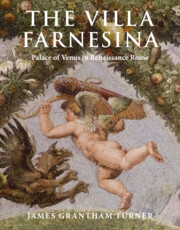25 results
4 - ‘Pornography’, ‘Obscenity’, and the Suppression of Libertine Literature
-
-
- Book:
- The Cambridge World History of Sexualities
- Published online:
- 26 April 2024
- Print publication:
- 16 May 2024, pp 71-93
-
- Chapter
- Export citation
20 - Erotic Literature in History
-
-
- Book:
- The Cambridge World History of Sexualities
- Published online:
- 26 April 2024
- Print publication:
- 16 May 2024, pp 443-466
-
- Chapter
- Export citation
2 - The Stanza del Fregio and Peruzzi’s First Architectural Wall-Painting
-
- Book:
- The Villa Farnesina
- Published online:
- 06 October 2022
- Print publication:
- 06 October 2022, pp 95-137
-
- Chapter
- Export citation
Abbreviations and Frequently Cited Works
-
- Book:
- The Villa Farnesina
- Published online:
- 06 October 2022
- Print publication:
- 06 October 2022, pp xii-xiv
-
- Chapter
- Export citation
3 - The Lost Façade-Paintings
-
- Book:
- The Villa Farnesina
- Published online:
- 06 October 2022
- Print publication:
- 06 October 2022, pp 138-217
-
- Chapter
- Export citation
Index
-
- Book:
- The Villa Farnesina
- Published online:
- 06 October 2022
- Print publication:
- 06 October 2022, pp 494-502
-
- Chapter
- Export citation
4 - 1512 Overtures
-
- Book:
- The Villa Farnesina
- Published online:
- 06 October 2022
- Print publication:
- 06 October 2022, pp 218-323
-
- Chapter
- Export citation
Introduction
-
- Book:
- The Villa Farnesina
- Published online:
- 06 October 2022
- Print publication:
- 06 October 2022, pp 1-21
-
- Chapter
- Export citation
Acknowledgements
-
- Book:
- The Villa Farnesina
- Published online:
- 06 October 2022
- Print publication:
- 06 October 2022, pp ix-xi
-
- Chapter
- Export citation
5 - The Second Phase, 1518–1519
-
- Book:
- The Villa Farnesina
- Published online:
- 06 October 2022
- Print publication:
- 06 October 2022, pp 324-418
-
- Chapter
- Export citation
Notes
-
- Book:
- The Villa Farnesina
- Published online:
- 06 October 2022
- Print publication:
- 06 October 2022, pp 419-490
-
- Chapter
- Export citation
Photograph Credits
-
- Book:
- The Villa Farnesina
- Published online:
- 06 October 2022
- Print publication:
- 06 October 2022, pp 491-493
-
- Chapter
- Export citation
1 - ‘Antique’ Imagination and the Creation of the Villa-Palazzo
-
- Book:
- The Villa Farnesina
- Published online:
- 06 October 2022
- Print publication:
- 06 October 2022, pp 22-94
-
- Chapter
- Export citation

The Villa Farnesina
- Palace of Venus in Renaissance Rome
-
- Published online:
- 06 October 2022
- Print publication:
- 06 October 2022
Contents
-
- Book:
- The Villa Farnesina
- Published online:
- 06 October 2022
- Print publication:
- 06 October 2022, pp v-viii
-
- Chapter
- Export citation
Copyright page
-
- Book:
- The Villa Farnesina
- Published online:
- 06 October 2022
- Print publication:
- 06 October 2022, pp iv-iv
-
- Chapter
- Export citation
Ut pictura amor: The Reflexive Imagery of Love in Artistic Theory and Practice, 1500–1700. Walter S. Melion, Joanna Woodall, and Michael Zell, eds. Intersections: Interdisciplinary Studies in Early Modern Culture 48. Leiden: Brill, 2017. xlii + 770 pp. $287.
-
- Journal:
- Renaissance Quarterly / Volume 72 / Issue 3 / Fall 2019
- Published online by Cambridge University Press:
- 27 September 2019, pp. 1020-1021
- Print publication:
- Fall 2019
-
- Article
- Export citation
Chapter 29 - Sexuality
- from Part VI - Social Structures and Social Life
-
-
- Book:
- Samuel Richardson in Context
- Published online:
- 21 September 2017
- Print publication:
- 21 September 2017, pp 247-254
-
- Chapter
- Export citation
6 - The Erotic Renaissance
-
-
- Book:
- The Cambridge Companion to Erotic Literature
- Published online:
- 30 August 2017
- Print publication:
- 07 September 2017, pp 85-104
-
- Chapter
- Export citation
Eroticism in the Middle Ages and the Renaissance: Magic, Marriage, and Midwifery. Ian Frederick Moulton, ed. Arizona Studies in the Middle Ages and the Renaissance 39. Turnhout: Brepols, 2016. xvi + 172 pp. €70.
-
- Journal:
- Renaissance Quarterly / Volume 70 / Issue 2 / Summer 2017
- Published online by Cambridge University Press:
- 20 November 2018, pp. 708-710
- Print publication:
- Summer 2017
-
- Article
- Export citation



